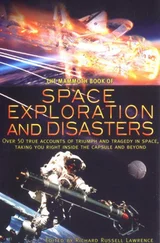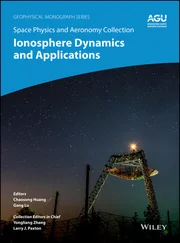1 Cover
2 Series Page
3 Title Page
4 Copyright Page
5 List of Contributors
6 Preface
7 Introduction: Space Weather Underlies Reliable Technologies REFERENCES
8 1 Effects of Space Radiation on Contemporary Space‐Based Systems I 1.1. INTRODUCTION 1.2. OVERVIEW OF SPACE RADIATION PROPERTIES 1.3. SPACE RADIATION EFFECTS 1.4. DISCUSSION AND CONCLUSIONS REFERENCES
9 2 Effects of Space Radiation on Contemporary Space‐Based Systems II 2.1. SURFACE CHARGING 2.2. INTERNAL (DEEP) CHARGING 2.3. PATH FORWARD REFERENCES
10 3 Effects of Space Radiation on Humans in Space Flight 3.1. INTRODUCTION 3.2. THE SPACE WEATHER ENVIRONMENT 3.3. RADIATION QUANTITIES, UNITS, AND SYMBOLS 3.4. RADIATION EFFECTS ON HUMANS 3.5. RADIATION LIMITS 3.6. REPRESENTATIVE SEP EVENT RADIATION EXPOSURES 3.7. SUMMARY AND CONCLUSIONS REFERENCES
11 4 Space Weather Radiation Effects on High‐Altitude/‐Latitude Aircraft 4.1. INTRODUCTION 4.2. THE PHYSICS OF ATMOSPHERIC RADIATION 4.3. MEASUREMENTS OF THE RADIATION ENVIRONMENT 4.4. REGULATORY ACTIVITIES 4.5. CONCLUSIONS REFERENCES
12 5 Remaining Issues in Upper Atmosphere Satellite Drag 5.1. INTRODUCTION 5.2. BACKGROUND 5.3. THE PHYSICS OF ATMOSPHERIC DRAG ON SPACECRAFT 5.4. THE LOWER REGISTER (100–500 KM ALTITUDE) 5.5. THE UPPER REGISTER (500–1000 KM) 5.6. SOLAR AND GEOMAGNETIC DRIVERS 5.7. CONCLUSIONS ACKNOWLEDGMENTS REFERENCES
13 6 Solar Radio Burst Effects on Radio‐ and Radar‐Based Systems 6.1. INTRODUCTION 6.2. CAUSE AND GENERAL CHARACTERISTICS OF EXTREME SOLAR RADIO NOISE 6.3. OCCURRENCE STATISTICS OF SOLAR RADIO BURSTS 6.4. NOTABLE SOLAR RADIO BURST IMPACTS REPORTED IN THE LITERATURE 6.5. CONCLUSIONS ACKNOWLEDGMENTS REFERENCES
14 7 Space Weather Influences on HF, UHF, and VHF Radio Propagation 7.1. INTRODUCTION 7.2. THE IONOSPHERE 7.3. RADIO PROPAGATION THROUGH AN IONIZED MEDIUM 7.4. IONOSPHERIC MORPHOLOGY AND DISTURBANCES 7.5. SOLAR STORM EFFECTS 7.6. SPACE WEATHER EFFECTS ON UHF/VHF AND HF USER APPLICATIONS 7.7. SUMMARY AND OUTSTANDING QUESTIONS ACKNOWLEDGMENTS REFERENCES
15 8 GNSS/GPS Degradation from Space Weather 8.1. INTRODUCTION 8.2. GNSS SPACE WEATHER EFFECTS, MONITORING, AND APPLICATIONS 8.3. SCIENTIFIC APPLICATION OF GNSS 8.4. GNSS APPLICATIONS 8.5. SUMMARY REFERENCES
16 9 Geomagnetic Field Impacts on Ground Systems 9.1. BACKGROUND FOR POWER SYSTEMS 9.2. GEOMAGNETIC STORM ENVIRONMENT MODEL 9.3. GROUND MODELS AND ELECTRIC FIELD CALCULATION 9.4. US ELECTRIC POWER GRID CIRCUIT MODEL 9.5. TRANSFORMER AND AC POWER GRID PERFORMANCE MODEL 9.6. THE EVOLVING VULNERABILITY OF ELECTRIC POWER GRIDS AND IMPLICATIONS FOR HISTORICALLY LARGE STORMS 9.7. SIMULATIONS AND REVIEW OF STORM IMPACTS ON THE US POWER GRID 9.8. DESCRIPTIONS OF DIFFERENT TYPES OF GEOMAGNETIC STORMS 9.9. IMPACTS ON OTHER TYPES OF GROUND SYSTEMS REFERENCES
17 Epilogue: The Road to Future Progress in Space Weather Understanding
18 Index
19 End User License Agreement
1 Chapter 2 Table 2.1 List of 23 satellite anomalies from 1971. (Reproduced with permissi... Table 2.2 Initial breakdown voltages for solar panel and thermal blanket samp... Table 2.3 Maximum E and B fields radiated by arcs on solar panel and thermal ... Table 2.4 Summary of CRRES IDM preflight deep charging ground test results. (...Table 2.5 Charge decay tests in vacuum yield resistivities and electrical tim...
2 Chapter 3Table 3.1 Skin dose thresholds.Table 3.2 Dose limits for short‐term or career noncancer effects (in mGy‐Eq o...Table 3.3 RBE values for noncancer effects of the eye lens, skin, blood formi...Table 3.4 ESA radiation exposure limits.Table 3.5 RSA radiation exposure limits.Table 3.6 JAXA organ radiation exposure limits.Table 3.7 JAXA career effective dose limits (Sv).Table 3.8 Organ dose and effective dose in cis‐Lunar space for female crew me...Table 3.9 Organ dose and effective dose in cis‐Lunar space for female crew me...Table 3.10 Organ doses and effective dose for female crew members for the Aug...Table 3.11 Organ dose and effective dose in cis‐Lunar space for female crew m...
3 Chapter 5Table 5.1 Solar indices related to atmospheric heating.Table 5.2 Characteristics of daily JB2008 solar indices.
4 Chapter 6Table 6.1 Burst PDF regression parameters.
1 Chapter 1 Figure 1.1 A modern‐day view of the Earth’s radiation belts as observed by t... Figure 1.2 A schematic diagram showing spacecraft impacts due to the space e... Figure 1.3 A map of the Earth showing contours of constant surface magnetic ... Figure 1.4 Illustration of the (a) single event upset, (b) deep‐dielectric d... Figure 1.5 Observed solar array current reduction on a high‐altitude spacecr... Figure 1.6 Long‐term (1992–2013) record of 2 ≤ E ≤ 6 MeV electrons measured ... Figure 1.7 Temporal correspondence between star tracker anomalies onboard a ... Figure 1.8 Induced attenuation of fiber optic cabling signals due to accumul...
2 Chapter 2 Figure 2.1 Local‐time distribution of anomalies observed by several geostati... Figure 2.2 “Musical” diagram showing 3‐hourly values of the planetary magnet... Figure 2.3 Phase space density of particles before and during eclipse Figure 2.4 Analysis suggested that DSCS II dielectric surfaces could charge ... Figure 2.5 Distribution of ATS‐6 charging events with local time and by volt... Figure 2.6 Discharges detected during eclipse charging event. Figure 2.7 Multiple discharges occurred during sunlit (differential) chargin... Figure 2.8 Most of the discharges detected by the CEEA occurred in the midni... Figure 2.9 Comparison of NASCAP predictions and in‐orbit observations of Kap... Figure 2.10 Comparison of NASCAP predicted spacecraft frame charging with ob... Figure 2.11 Large differential potentials were induced around the METEOSAT‐1... Figure 2.12 Worst‐case discharges are insensitive to mono‐, dual‐, and spect... Figure 2.13 Effect of sunlight (UV) intensity on charging of dielectrics and... Figure 2.14 Example of discharge occurrences during conditions of reduced su... Figure 2.15 “Wishbone map” of surface charging hazard risks versus altitude ... Figure 2.16 Local time distribution of all anomalies. Figure 2.17 Seasonal distribution of all anomalies. Figure 2.18 Local time and seasonal distribution of anomalies on GOES 4, 5, ... Figure 2.19 TDRS‐1 CVU anomalies associated with very specific local time an... Figure 2.20 Local time distribution of antenna positioner electronic upsets... Figure 2.21 Surface charging initiated sustained vacuum arcs begin with conv... Figure 2.22 Sustained arc and permanent damage that occurred during EOS‐AM g... Figure 2.23 Source of commercial satellite anomalies by number (left) and am... Figure 2.24 Safe voltage and current limits that prevent sustained arcs deri... Figure 2.25 Evidence of substorm activity from local magnetograms and aurora... Figure 2.26 Example ground magnetogram and auroral X‐ray image near satellit... Figure 2.27 Correlation of PORs with high energy electron fluence. Figure 2.28 Typical electron flux‐energy spectrum at 4.5 R J. Figure 2.29 Correlation of DSP star tracker shutter anomalies with GOES‐2 >1... Figure 2.30 In‐orbit electron fluxes Vs energy and fluxes that produced ESD ... Figure 2.31 Correlation of two anomalies to high fluxes of extremely energet... Figure 2.32 Designation of surface versus internal discharges is supported b... Figure 2.33 Frequency distribution of internal discharges versus 1.4 MeV ele... Figure 2.34 Number and amplitude of surface versus internal discharges. Figure 2.35 Photograph of IDM experiment tray, with sixteen 5 cm x 5 cm plan... Figure 2.36 Configurations used for IDM samples. Small circles indicate conn...
Читать дальше












